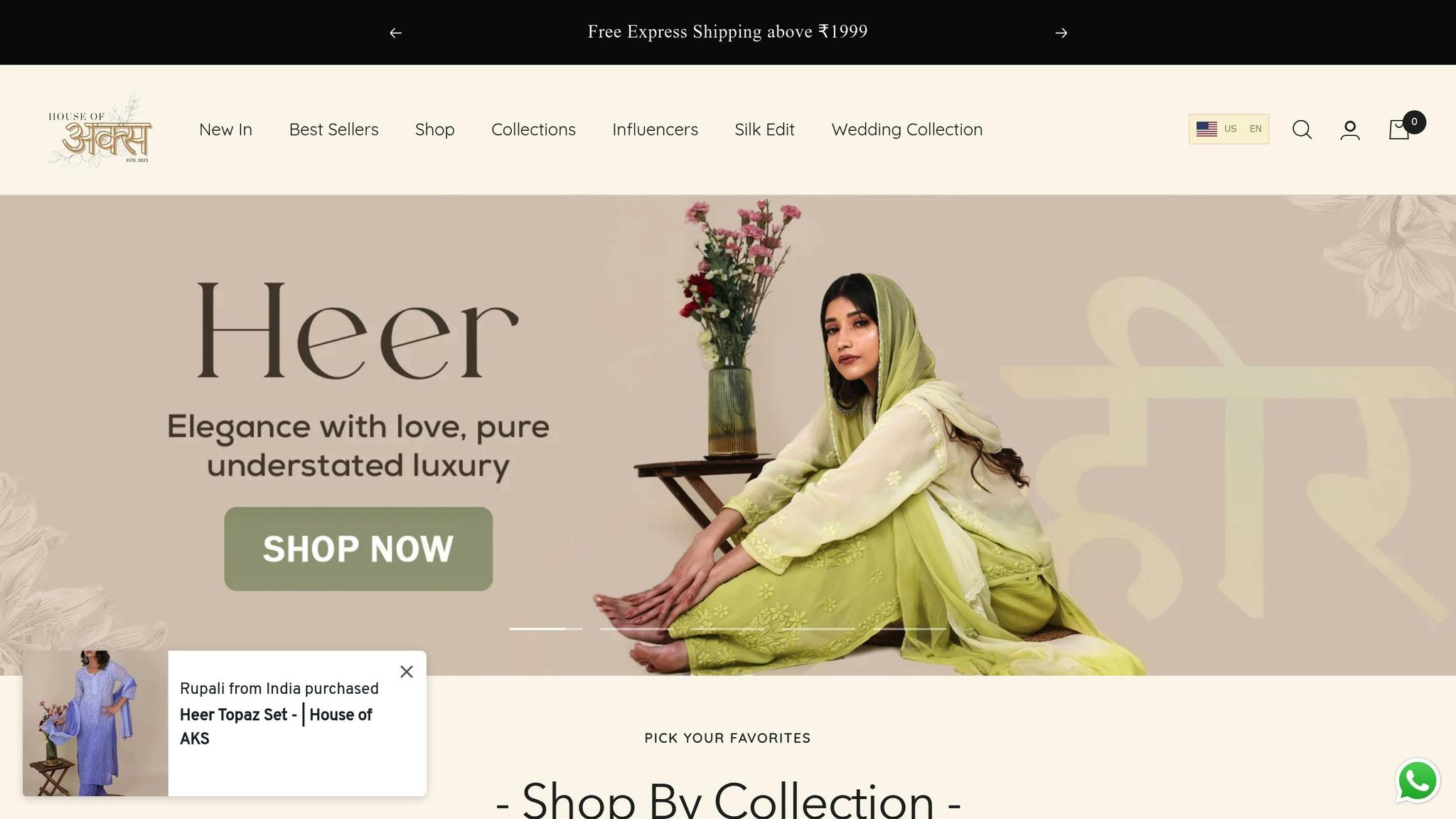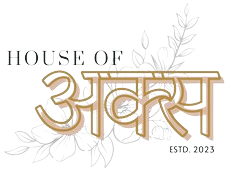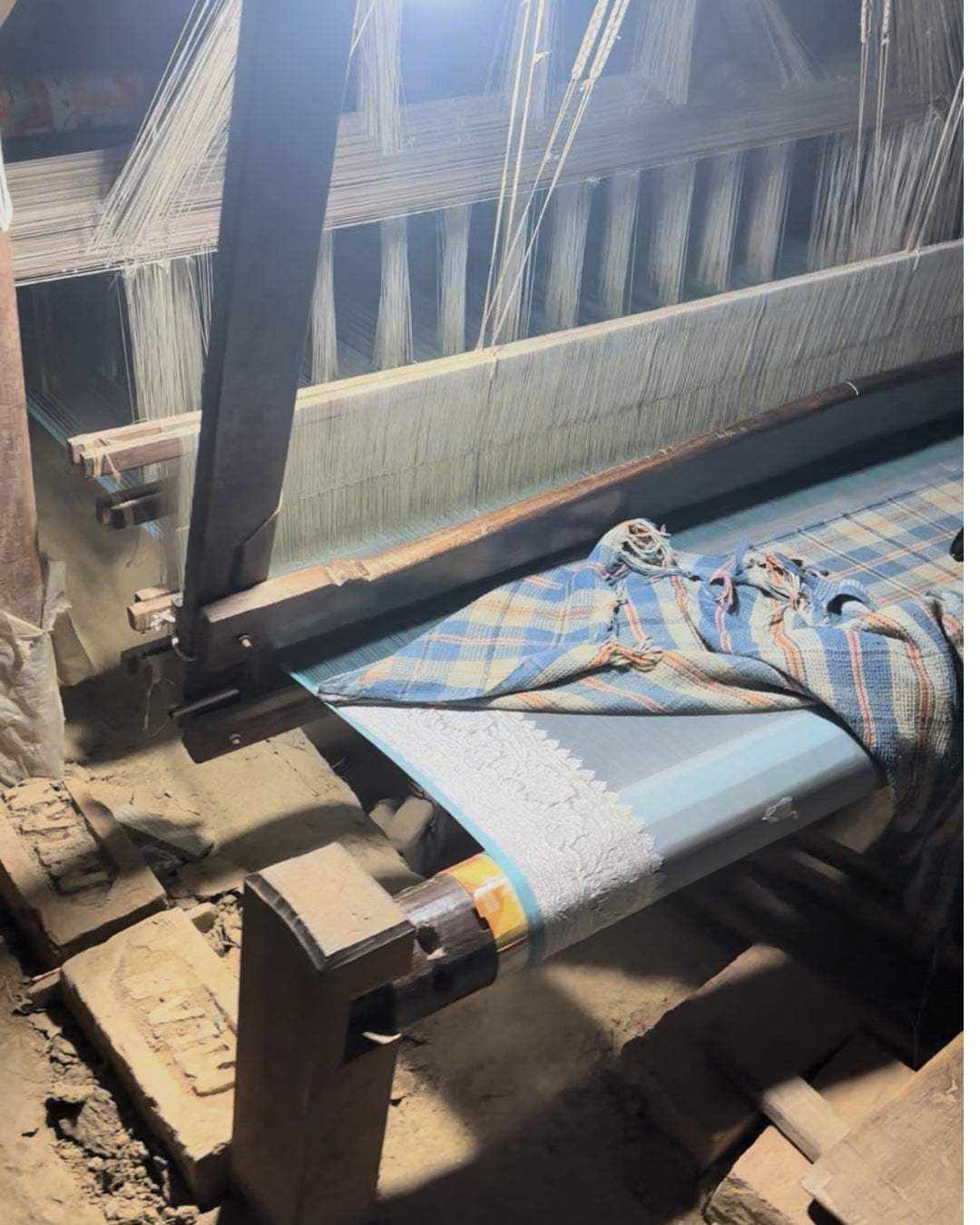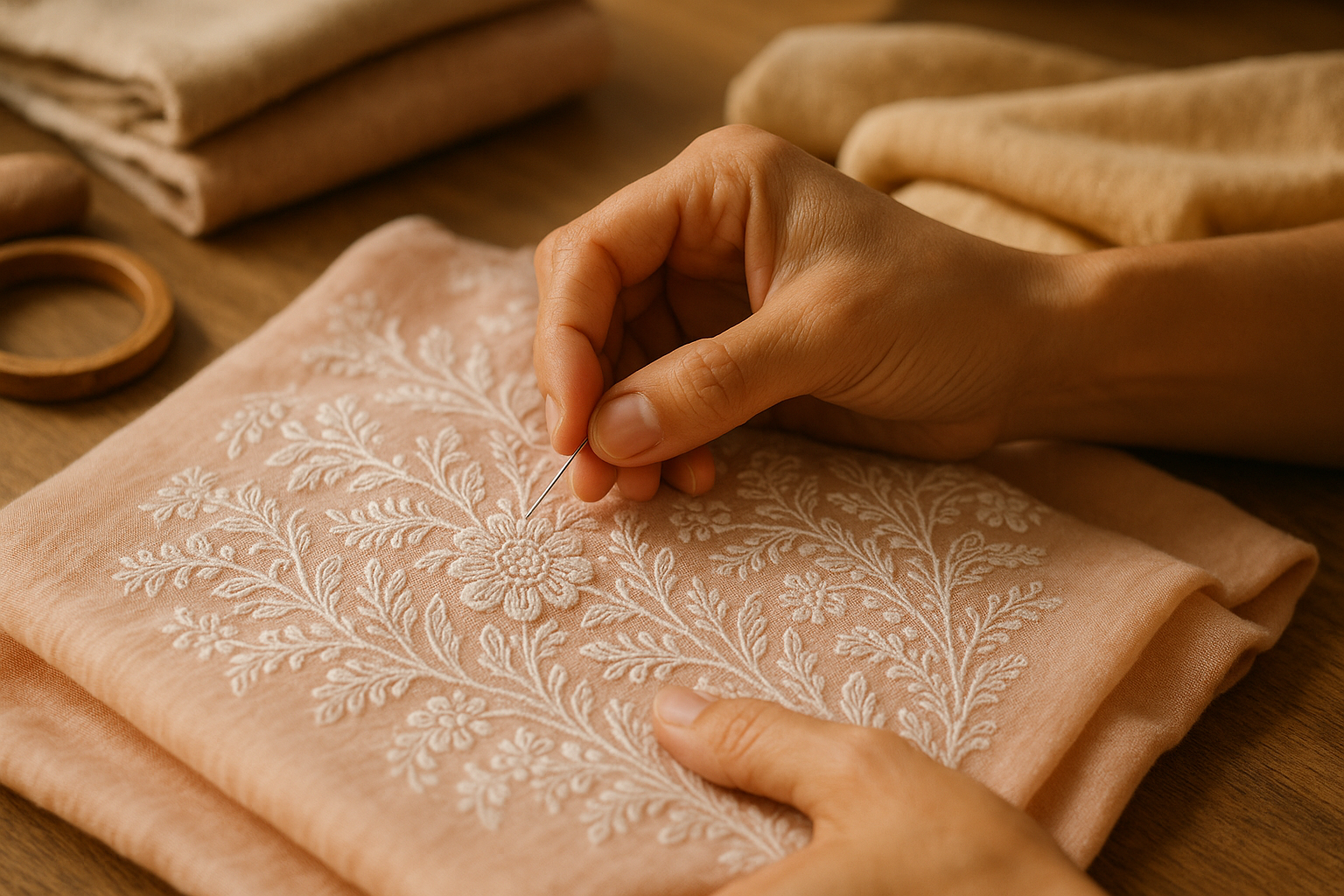How to Choose Perfect Banarasi Saree Colours
Choosing the right Banarasi saree colour is about balancing tradition, personal style, and the occasion. Here's a quick guide:
-
Skin Tone Matters: Identify your undertone (cool, warm, or neutral) to find shades that enhance your natural beauty. For example:
- Cool undertones: Lavender, royal blue, magenta.
- Warm undertones: Mustard yellow, maroon, rust orange.
- Neutral undertones: Both warm and cool shades work.
-
Event-Specific Colours:
- Weddings: Red, maroon, gold.
- Festivals: Yellow, royal blue, saffron.
- Casual outings: Earthy tones or pastels like blush pink and mint green.
-
Classic vs. Modern Choices:
- Timeless: Red-gold, green-gold, blue-silver.
- Contemporary: Pastels like lavender-silver or bold combos like hot pink-purple.
Banarasi sarees reflect heritage while letting you express your style. Whether you prefer traditional pairings or modern hues, your confidence in wearing the saree makes all the difference.
The History Behind Banarasi Saree Colours
The vibrant colours of Banarasi sarees trace their roots back centuries to Varanasi, where skilled weavers crafted palettes inspired by India's rich heritage. These colours were carefully chosen, each reflecting deep cultural and historical significance.
The origins of Banarasi sarees can be traced to the Mughal era, a time when Persian artisans brought their weaving techniques to India and blended them with local traditions. During this period, weavers used pure gold and silver threads to create intricate patterns that continue to influence designs today. This cultural exchange gave rise to a unique colour palette, combining Islamic artistic styles with indigenous Indian traditions.
What Banarasi Colours Mean in Indian Culture
The colours of Banarasi sarees are more than just aesthetic choices - they serve as a medium of storytelling, embodying emotions, beliefs, and cultural identity. Each hue carries a unique significance.
"Red is considered an auspicious colour in Indian culture and is believed to symbolise love, passion, and fertility".
In North India, red is synonymous with marital bliss, often tied to the tradition of sindoor. In South India, it symbolises fertility and purity. Brides frequently choose red for its association with good luck and prosperity.
Green, on the other hand, is a symbol of harmony, balance, and the rejuvenating power of nature. This colour is deeply connected to fertility and is often seen during festivals celebrating new beginnings and harvests.
Yellow holds a special place in Indian traditions for its associations with purity and auspiciousness. It is a colour that radiates positivity and is often chosen for ceremonies and celebrations.
The colours of Banarasi sarees are a reflection of societal values, religious beliefs, and regional customs, weaving a narrative that connects generations through shared cultural stories.
How Banarasi Colour Styles Have Changed Over Time
While tradition forms the backbone of Banarasi saree designs, evolving tastes and trends have brought new dimensions to their colour palettes. The transformation of Banarasi saree colours mirrors the shifts in India's social and fashion landscapes over time.
During the Mughal era, sarees prominently featured Islamic-inspired motifs, such as floral patterns and intricate leaf designs. In the British era, geometric patterns were introduced, adding variety to the traditional palette.
Today, Banarasi sarees showcase a blend of traditional and modern aesthetics. Patterns inspired by geometry, abstract art, and nature now adorn lighter fabrics like organza and georgette. Pastel shades and unconventional colours have also found their way into the mix.
Experts have observed a growing preference for neutral tones and minimalistic motifs in contemporary Banarasi sarees. While the essence of this traditional craft remains intact, these updates cater to modern lifestyles and tastes.
In 2019, during National Handloom Day celebrations at Banaras Hindu University, the textiles ministry signed agreements with educational institutions to support weavers and their families. This initiative aimed to preserve traditional weaving knowledge while encouraging innovation in design and colour.
Today’s Banarasi sarees strike a balance between tradition and modernity. The timeless bright hues now coexist with neutral tones and understated designs, offering women versatile options to express their personal style while celebrating a heritage that continues to inspire. This evolution highlights how traditional craftsmanship adapts to meet contemporary aesthetics.
Picking Banarasi Saree Colours for Your Skin Tone
Choosing the perfect Banarasi saree colour can elevate your look, but the key lies in understanding your skin tone. These sarees come in a dazzling range of colours, and picking the right one can enhance your natural beauty and confidence. Let’s explore how to determine your skin's undertone and use it to select colours that truly complement you.
"When you're looking for clothes to match your skin tone, you're actually looking for clothes that complement your skin's undertone rather than the surface tone." - Penner's
Your undertone stays constant throughout your life, unlike your surface tone, which can shift with sun exposure or seasonal changes. This makes identifying your undertone essential for choosing colours that always flatter you, while honouring the timeless elegance of Banarasi sarees.
How to Find Your Skin Undertone
Finding your undertone is simpler than it seems. Here are a few quick tests:
"While skin tones range from fair to dark, undertones are the cool, warm or neutral tinges within your skin tone." - Stitch Fix
- Vein Test: Look at the veins on your wrist under natural light. If they appear blue or purple, you have cool undertones. If they look green or olive, you have warm undertones. If it’s hard to tell, you likely have neutral undertones.
- Sun Reaction: If you burn easily and rarely tan, your skin likely has cool undertones. If you tan quickly with little burning, warm undertones are more likely. Neutral undertones often fall somewhere in between.
- Jewellery Test: Try on silver and gold jewellery. Silver usually flatters cool undertones, while gold enhances warm undertones. If both look equally good, you may have neutral undertones.
Once you’ve identified your undertone, it’s time to discover which Banarasi saree colours will make you shine.
Best Colours for Each Undertone Type
Knowing your undertone simplifies the process of selecting the perfect saree shade.
- Cool Undertones: Shades with blue or purple bases work wonders. If you have fair skin, go for pastels like light pink, mint green, peach, or lavender. Medium skin tones can embrace bolder hues like turquoise, emerald green, royal blue, and magenta.
- Warm Undertones: Colours with golden or yellow bases are ideal. Dusky skin pairs beautifully with earthy tones like caramel, mustard yellow, rust orange, and beige. Darker skin tones look stunning in rich, deep colours such as maroon, forest green, navy blue, and deep purple.
- Neutral Undertones: Lucky you! You can experiment with both warm and cool shades. Feel free to play with colours based on your mood, the occasion, or even the latest trends.
But what if you’re unsure or want a shade that works universally? Let’s look at colours that flatter everyone.
Colours That Look Good on Everyone
Some Banarasi saree colours transcend skin tones and look fabulous on everyone.
- Red: A classic that complements all complexions.
- Black: Timeless and elegant, especially with gold or silver zari work. Perfect for formal events or evening celebrations.
- Maroon: A versatile choice for autumn and winter occasions.
- Green and Purple: Shades like emerald green, forest tones, or regal purples add sophistication and suit various skin tones.
- Pastels: Soft pink, powder blue, and mint green are ideal for daytime events and spring celebrations.
Ultimately, while these tips provide a great starting point, the best saree colour is the one that makes you feel radiant and confident. Trust your instincts and let your personality shine through your choice.
Choosing Colours Based on Events and Your Style
Just like the timeless art of Banarasi weaving, the colours you choose for your saree can beautifully blend tradition with your personal style. The event you're attending often sets the tone for your colour selection. It’s about matching the mood of the occasion while staying true to your own aesthetic. By balancing classic tones with modern shades, you can make choices that showcase your individuality with confidence.
Classic vs. Modern Colours for Different Events
For weddings, traditional ceremonies often lean towards red, symbolising love and strength. Shades like maroon-gold and pink - ranging from soft blush to vibrant rani - are popular for their romantic appeal. Modern brides, however, are experimenting with bold choices like hot pink with floral designs for summer or deep tones like mulberry and burgundy with intricate zari work for winter weddings.
During festivals, bright colours take centre stage. Yellow and golden Banarasi sarees are perfect for Haldi ceremonies, representing joy and auspiciousness. For celebrations like Diwali, Navratri, or Eid, royal blue creates a regal festive look, while mustard and saffron add a culturally rooted vibrancy.
For sangeet nights and receptions, you can explore playful yet elegant options. Deep blue or red sarees with floral accents add charm. Golden sarees bring glamour, while purple tones make a bold statement. If you want a modern touch, light turquoise or soft grey sarees offer a fresh perspective.
When it comes to formal events, refined tones like navy, burgundy, or charcoal grey exude sophistication. Black paired with cream creates a polished, modern look, symbolising strength and elegance.
For casual outings, relaxed tones work best. Earthy colours like terracotta and mustard yellow offer a grounded, natural vibe, perfect for informal or semi-formal settings. Pastel shades are ideal for daytime events or summer gatherings. Time and season also play a role - lighter shades are great for daytime, while richer hues stand out in the evening. In summer, breezy colours keep you comfortable, while warm tones are perfect for winter.
These thoughtful, event-specific choices not only enhance your look but also reflect your personality.
Using Colour to Show Your Personal Style
Beyond the occasion, your personal style is a key factor in choosing colours. The shades you wear can speak volumes about your personality. Bold individuals often gravitate towards purple, green, or teal, while those with traditional preferences may lean towards red, gold, or maroon. Jewel tones like emerald and sapphire offer a dramatic flair, while metallic finishes - gold, silver, or bronze - add a touch of glamour.
If you prefer understated elegance, earthy tones like terracotta and mustard yellow create a sophisticated and subtle look suitable for various occasions. Modern fashion lovers can also opt for bold, oversized floral prints, which work wonderfully for casual gatherings or daytime parties. This mix of traditional craftsmanship and contemporary design is perfect for those who like to make a statement.
Coordinating your saree with accessories can further elevate your style. A contrasting blouse can create a striking effect, while matching tones offer a harmonious appearance. Jewellery also plays a crucial role - gold pairs beautifully with warm colours, while silver enhances cooler shades.
Whether you’re inspired by celebrities like Deepika Padukone, Vidya Balan, Rekha, or Anushka Sharma, who have all dazzled in Banarasi sarees at weddings and red-carpet events, or you’re carving out your own style path, let your choice of colour reflect your true self while celebrating the rich heritage of Banarasi sarees.
sbb-itb-380d000
Popular Banarasi Saree Colour Combinations
Banarasi sarees are celebrated for their intricate designs and luxurious fabrics, but what truly sets them apart is their stunning colour combinations. Over the years, these combinations have evolved, blending traditional aesthetics with modern trends. Whether you're drawn to timeless classics or bold contemporary palettes, understanding these pairings can help you choose a saree that complements your personal style and suits the occasion perfectly.
Classic Colour Combinations That Never Go Out of Style
Some colour pairings in Banarasi sarees are simply eternal. They carry a sense of tradition and elegance that transcends trends. Red and gold, for instance, is the quintessential combination. Rich and regal, it’s a favourite for bridal wear and wedding ceremonies, exuding a sense of grandeur and timeless beauty.
Another standout is royal blue with silver, a pairing that radiates sophistication. Perfect for evening events, this combination uses the deep, rich blue as a backdrop to highlight intricate silver zari work, creating a look that's both majestic and understated.
Green and gold is another evergreen duo. This combination offers a luxurious appeal, with the richness of green enhanced by the opulence of gold zari detailing. It's a versatile choice that works beautifully across a range of traditional events.
New Colour Combinations for Modern Looks
Modern Banarasi sarees have embraced a fresh wave of colour combinations that cater to contemporary tastes without losing their traditional charm. Pastel shades are making waves in 2025, offering a softer, more understated elegance. Think blush pink with ivory, mint green with gold, or lavender with silver - these combinations are perfect for everything from casual gatherings to grand celebrations.
For those who prefer bolder choices, the mint green and hot pink pairing is a striking option that combines traditional craftsmanship with a youthful, modern edge. Similarly, a maroon Banarasi saree paired with a dark green blouse is a delightful blend of classic and contemporary styles.
Another modern favourite is hot pink with purple, a vibrant and playful combination ideal for sangeet nights or festive celebrations. On the other hand, if you lean towards subtler styles, a white and gold Banarasi saree paired with a designer green blouse offers a refined, fusion-inspired look.
"As 2025 unfolds, saree fashion is all about personal expression - whether you gravitate towards the dreamy softness of pastels or the timeless allure of vibrants, the key is to wear your saree with confidence."
Modern styling also extends to how these sarees are worn. Pairing them with crop tops, blazers, or other fusion pieces creates a contemporary look that resonates with younger generations. Lightweight Banarasi tissue sarees in pastel hues are particularly popular for their comfort and chic appeal, making them a go-to choice for modern wearers.
Comparison: Classic vs. Modern Colour Combinations
Choosing between classic and modern colour combinations often depends on the occasion, your personal preferences, and the statement you want to make. Here’s a quick comparison to help you decide:
| Aspect | Classic Combinations | Modern Combinations |
|---|---|---|
| Best Occasions | Weddings, religious ceremonies, formal traditional events | Contemporary celebrations, casual gatherings, fusion events |
| Cultural Significance | Deeply rooted in tradition, rich in symbolic meaning | Focused on personal expression and current fashion trends |
| Versatility | Timeless and suitable for all generations | Trendy, appealing especially to younger audiences |
| Styling Approach | Traditional draping with classic jewellery | Experimental, featuring fusion accessories like belts or modern blouses |
Classic combinations like red with gold or royal blue with silver are perfect for traditional family events, offering a sense of heritage and elegance. Meanwhile, modern combinations such as blush pink with ivory or hot pink with purple are ideal for contemporary celebrations, allowing for creative styling and a more personalised touch.
Ultimately, the choice between classic and modern comes down to your individual style and the occasion. Whether you opt for the timeless charm of traditional pairings or the fresh appeal of contemporary palettes, the beauty of a Banarasi saree lies in its ability to adapt to every mood and moment.
House of AKS: Our Banarasi Saree Colour Range

At House of AKS, we honour the rich heritage of Banarasi weaving while embracing modern elegance. Our carefully curated colour range ensures that every woman can discover a saree that resonates with her style. Dive into our collections to explore the beautiful palettes that define our designs.
Special Colour Collections at House of AKS
Our sarees feature a harmonious blend of timeless hues and contemporary shades. From soft pastels like powder blue and blush pink to bold, vibrant tones, we offer something for both lovers of tradition and enthusiasts of modern fashion.
Take our tissue silk collection, for example. The Azure Bliss Khaddi Georgette Banarasi Saree in Firozy channels the tranquil beauty of turquoise waters, while our Blush Royale sarees present a refined version of pink. For those drawn to metallics, Golden Gleam and Sheen Gold deliver a luminous, eye-catching finish. Nature-inspired shades like Celestial Green, Handloom Green, and Handloom Blue add a fresh touch, while playful tones such as Pearl Pink and Pink-A-Boo bring a lively charm. For a more understated elegance, our Grey collection offers subtle sophistication, and our Black Banarasi sarees exude timeless drama. Every piece reflects our effort to blend traditional craftsmanship with modern aesthetics.
We also offer seasonal collections tailored for special occasions. Heer, for instance, is a Valentine's Day edit featuring romantic colour combinations, while Chaand, our festive collection, is designed with celebratory hues in mind. Whether it’s a wedding, festival, or intimate gathering, these collections ensure you’ll find the perfect saree for the moment.
Our Commitment to Quality and Fair Production
At House of AKS, our dedication to authentic craftsmanship goes beyond colour. Each Banarasi saree is a testament to our commitment to quality and ethical practices. We source premium silk from Varanasi, a city famed for its pure silk, which forms the foundation of genuine Banarasi sarees. Our designers collaborate with skilled weavers, blending age-old techniques with contemporary designs to ensure that every saree reflects the true essence of Banarasi artistry.
We maintain strict quality standards throughout our production process. From selecting the finest silk and intricate handwoven patterns to using pure zari (gold or silver thread), every detail is meticulously crafted. Our small-batch production model not only ensures high-quality products but also supports artisan communities by providing fair wages.
At the heart of our work is a deep respect for the artisans who bring these sarees to life. As we proudly say:
"Each piece is an ode to the artisans who pour their passion into their craft, and to you, the wearer, who carries a piece of India's heart and soul. Embrace the art, feel the emotion, and become part of the timeless tale that is House of AKS. Welcome home to the heart of Chikankari craftsmanship."
Choosing a Banarasi saree from House of AKS means more than selecting a beautiful piece of clothing. It’s about supporting traditional artistry, celebrating heritage, and embracing innovation. Our colour range reflects our mission to preserve India’s textile traditions while offering modern women designs that stand for quality, authenticity, and ethical production.
Conclusion: Find Your Perfect Banarasi Saree Colours
Picking the right Banarasi saree colour becomes effortless when you follow some simple principles. Start with your skin undertone - warm undertones pair beautifully with shades like gold, peach, and coral, while cool undertones look stunning in silver, lavender, and emerald green. And while these guidelines help, your confidence in wearing the saree is what truly makes it shine.
Your choice should also reflect the occasion and your personal style. For weddings and grand celebrations, rich, bold colours make a striking statement. On the other hand, casual gatherings are the perfect setting for soft pastels adorned with delicate embroidery. Let your unique style guide your decision.
Cultural traditions also play a role in saree colour selection. Classic hues like red and maroon remain timeless favourites, while modern shades - pastels and jewel tones - add a contemporary twist to traditional designs. For traditional ceremonies, colours like red, blue, gold, purple, and green are ideal. Meanwhile, modern events allow for experimenting with fresh palettes. By blending personal preference with tradition, you’re sure to find a colour that feels just right.
| Saree Colour | Ideal Occasion |
|---|---|
| Red Sarees | Weddings, Engagements, Karva Chauth, Festivals |
| Green Sarees | Mehndi Ceremonies, Traditional Puja, Eco-themed Events |
| Blue Sarees | Evening Parties, Corporate Events, Receptions |
| Pink Sarees | Baby Showers, Birthday Parties, Romantic Dinners |
| Yellow Sarees | Haldi Ceremonies, Daytime Functions, Spring Events |
The charm of Banarasi sarees lies in how they effortlessly weave tradition with individuality. Whether you choose a timeless classic or a modern hue, let your saree reflect your personality while honouring its rich heritage. Every thread tells a story, and your choice adds to its legacy.
Celebrate your style and the artistry of Banarasi craftsmanship with a colour that feels uniquely yours.
FAQs
How do I identify my skin undertone to pick the best Banarasi saree colours?
To figure out your skin undertone and pick the most flattering Banarasi saree colours, you can use these quick and easy methods:
- Look at your wrist veins: If your veins appear greenish, you likely have a warm undertone. If they seem bluish or purplish, you probably have a cool undertone. A mix of both? That suggests a neutral undertone.
- Test with gold or silver jewellery: Notice how your skin reacts to jewellery. Gold jewellery tends to enhance warm undertones, while silver works better for cool undertones.
Once you’ve identified your undertone, choose saree colours that complement it. For warm undertones, shades like red, mustard, and coral bring out a natural glow. If you have cool undertones, go for colours like royal blue, emerald green, or pastel pink. And if your undertone is neutral, you’re in luck - you can pull off a wide variety of shades with ease.
What are some modern yet traditional colour combinations for Banarasi sarees?
Modern Banarasi sarees bring together the charm of traditional artistry with the elegance of contemporary colour palettes. Some standout combinations are lavender with gold, lemon yellow with silver, and pastel pink with gold, offering a refreshing and stylish vibe. If you're drawn to classic elegance, pairings like deep red with gold and royal blue with silver remain evergreen favourites.
These colour blends not only showcase the intricate weaving legacy of Banarasi sarees but also ensure you make a statement at weddings, festivals, or formal gatherings.
How have Banarasi saree colour trends changed over the years, and what influences these changes?
Banarasi sarees have seen a fascinating shift in colour preferences over time. While the traditional palette centred around rich reds, golden hues, and royal blues, drawing inspiration from Mughal and Persian artistry, today's trends lean towards pastels, neutrals, and earthy tones. This mix of classic and modern reflects how heritage craftsmanship adapts to suit evolving tastes.
This change is largely shaped by the influence of global fashion trends and the desire for sarees that effortlessly transition from traditional ceremonies to contemporary events. Weavers are now exploring fresh colour pairings and innovative patterns, striking a balance between preserving the timeless charm of Banarasi sarees and appealing to younger, style-conscious audiences.





